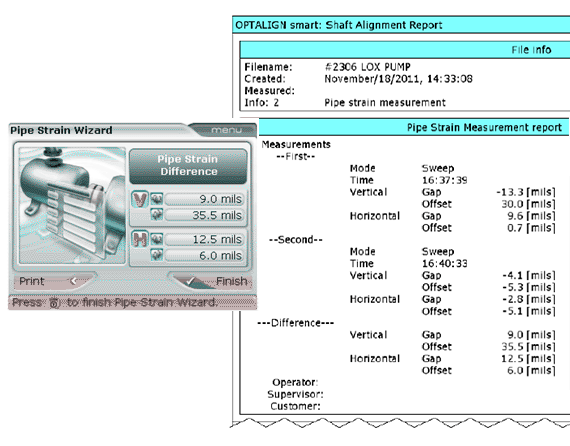Yes, pipe strain is soft foot!
Soft foot means machine frame distortion. If you are missing shims under a foot and tighten the hold-down bolt until you have forced the foot down to the base, you will have distorted the machine frame. If you have severe pipe stress on a pump, and the anchor bolts are tight, chances are great you are also distorting the pump casing.
Consider that if the pump’s anchor bolts were completely loosened or removed, the pump might be hanging in the air from the piping. So if you were now to tighten the anchor bolts, you would be forcing the pump down to the base and distorting it, just as happens when you are missing shims under a foot.
Shimming the feet will rarely solve the problem completely; rather, the correct solution is to eliminate the undesirable pipe stress. “Stress” is the force acting on something, while “strain” is the deflection or distortion resulting from the stress. A soft foot condition means you have machine frame strain, and pipe stress is just one of several examples of this. When the machine casing is distorted, the internal alignment between the bearings is changed and the shaft is deflected. This produces enormous stress on the bearings and increased vibration in your machines, resulting in premature wear and tear as well as loss of efficiency. Your seals and bearings will fail much faster. If a significant soft foot condition exists, a good alignment of the centerlines of the shaft rotation is almost pointless. The machines will still fail more quickly and lose efficiency. How do we diagnose and fix this?
The trick lies in knowing how to recognize that a pipe strain problem exists. The behavior of a machine with pipe strain differs significantly from one whose soft foot condition is caused by one of the more traditional shimming problems or unevenness of the base or feet. Fortunately, there is an easy measurement solution: The Pipe Strain Wizard in the OPTALIGN® SMART. The Pipe Strain Wizard will guide you through all of the necessary steps to quickly and easily ascertain whether a pipe strain problem exists and measure its precise impact on the shaft alignment.
Essentially the process involves taking an initial reference reading of the shaft alignment condition. Thereafter the piping is completely loosened and a second reference reading is taken. The wizard then calculates the difference and yields the results.
These results can be documented in a full-color Pipe Strain report printed directly from the OPTALIGN SMART to a USB memory stick as a PDF file.

Any impact on the alignment of more than about 2 mils indicates a pipe strain problem that should be dealt with. Correcting pipe strain is a task for an experienced pipefitter who must see to it that connecting and torquing the piping should not move the machine from its rough aligned condition, nor distort its casing in any way. Proper pipe hanging techniques and a good knowledge of calculating and designing “Dutchman” spacers are essential.
Filed under:
Alignment, Articles and Case Studies by Alan Luedeking CRL CMRP
